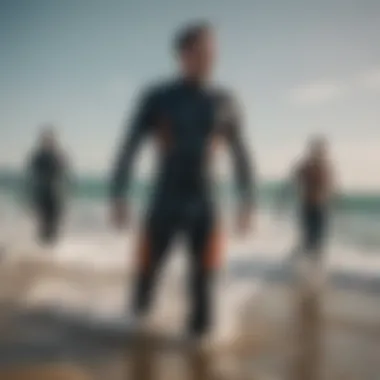Unlocking the Perfect Wetsuit for Kitesurfing Enthusiasts


Equipment Reviews
When it comes to choosing the perfect wetsuit for kitesurfing and kiteboarding, understanding the equipment is crucial. From kites to boards and accessories, each component plays a vital role in enhancing your riding experience. Let's delve into an overview of the latest kite models, considering features like shapes, sizes, materials, and renowned brands. The right kite can elevate your performance on the water, so selecting one that suits your style and skill level is paramount.
Moving on to kiteboarding boards, there's a wide array of options available, including twintips and directional boards. It's essential to review the design, construction, and riding style suitability of different boards to match them with your preferences and riding techniques. Additionally, discussing essential accessories like harnesses, lines, pumps, and safety gear is necessary. Harnessing the power of the wind safely requires well-maintained and suitable accessories that not only enhance performance but also ensure your safety during every session.
Introduction
Wetsuits are a crucial component for kitesurfing and kiteboarding enthusiasts, providing insulation in chilly waters while enhancing comfort and mobility. Understanding the intricacies of selecting the right wetsuit is paramount to enjoying an optimal experience on the waves. Beyond mere apparel, wetsuits act as a shield against the elements, enabling riders to extend their sessions without succumbing to the cold. Novices and seasoned riders alike must grasp the nuances of wetsuit selection to ride the waves with confidence and ease. This article delves into the essential facets of choosing the ideal wetsuit for kitesurfing and kiteboarding adventures, offering a detailed exploration of neoprene thickness, fit considerations, style preferences, and more. By dissecting each element meticulously, readers will acquire a comprehensive understanding of how to navigate the diverse world of wetsuits, ensuring a rewarding and comfortable time on the water.
Understanding Neoprene Thickness
When it comes to kitesurfing and kiteboarding, understanding neoprene thickness plays a pivotal role in your overall experience on the water. Neoprene, a synthetic rubber material, is the fundamental component of wetsuits, responsible for providing insulation and keeping you warm in varying water temperatures.
The thickness of neoprene directly impacts the wetsuit's thermal properties and flexibility, making it crucial to select the right thickness based on the environmental conditions you will be encountering. In cold waters, a thicker neoprene ensures better insulation, while in warmer climates, a thinner neoprene offers more flexibility and freedom of movement.
Moreover, neoprene thickness influences buoyancy levels, affecting your body position in the water. Thicker neoprene tends to provide more buoyancy, which can be advantageous for beginners or individuals looking for extra floatation. On the other hand, thinner neoprene promotes a closer and more natural fit, enhancing agility and maneuverability.
When choosing a wetsuit for kitesurfing and kiteboarding, consider the typical water temperatures of your location, the duration of your sessions, and your personal comfort preferences. Understanding how neoprene thickness correlates with insulation, flexibility, and buoyancy will empower you to make an informed decision tailored to your specific needs and performance expectations.
Considering Proper Water Temperature for Wetsuits


Water temperature plays a crucial role in determining the appropriate wetsuit thickness for kitesurfing and kiteboarding activities. Understanding the impact of water temperature on your body is essential to ensuring optimum comfort and safety while engaging in these water sports. Different water temperatures necessitate varying levels of insulation provided by wetsuits to prevent hypothermia or overheating. It's imperative to choose a wetsuit that offers the right balance between warmth and mobility, depending on the specific water conditions you'll encounter. The knowledge of how your body reacts to different water temperatures can significantly enhance your overall performance and enjoyment on the water. Factors such as air temperature and wind chill also influence the effective temperature your body experiences while kitesurfing or kiteboarding, making it crucial to select the appropriate wetsuit thickness for the prevailing environmental conditions.
Assessing Fit and Mobility
When considering the right wetsuit for kitesurfing or kiteboarding activities, undoubtedly Fit and Mobility becomes a crucial aspect to delve into. The wetsuit should fit snugly yet allow for a full range of motion, enabling the rider to maneuver effortlessly through the water.
Fit plays a pivotal role in ensuring that the wetsuit functions effectively. A wetsuit that is too loose will allow water to seep in, causing discomfort and ultimately reducing the insulating properties of the suit. Conversely, a wetsuit that is too tight will restrict movement and lead to chafing, hindering performance and overall experience.
To determine the right fit, it is essential to consider various factors such as body shape, height, and weight. Different manufacturers may have slightly different sizing charts, so trying on the wetsuit before purchasing is highly recommended. Additionally, paying attention to the wetsuit's seams and how they align with your body can also impact comfort and mobility.
Mobility, on the other hand, is intertwined with fit. A well-fitted wetsuit will facilitate unrestricted movement, allowing the kitesurfer or kiteboarder to execute maneuvers with precision and ease. Stretch panels strategically placed in areas like the shoulders, knees, and elbows can further enhance mobility without compromising insulation.
Moreover, assessing mobility goes beyond just the physical movements. It involves understanding how the wetsuit interacts with the rider's body during dynamic actions on the water. Ensuring that the wetsuit does not impede crucial movements for kitesurfing or kiteboarding, such as paddling out, popping up on the board, or carving through waves, is paramount.
Evaluating Style Preferences
When it comes to kitesurfing and kiteboarding, evaluating style preferences plays a significant role in enhancing both performance and comfort during your session. Understanding your individual style preferences can make a substantial difference in how you feel and move in the water.
Firstly, determining your style preferences involves considering factors such as the design and color of the wetsuit. Some riders may prefer vibrant and eye-catching colors, while others opt for more subdued and sleek designs. These preferences can reflect personal style and attitude, adding a touch of individuality to your gear.
Moreover, the style of the wetsuit can also impact functionality. For example, some riders may prioritize wetsuits with additional padding in specific areas for protection during intense maneuvers, while others may prefer wetsuits with streamlined designs for minimal drag in the water.
Beyond aesthetics, evaluating style preferences can involve choices related to the closure system of the wetsuit. Whether you prefer back-zip, chest-zip, or zip-free closures, each option offers its unique benefits in terms of ease of entry, flexibility, and water seal.


Additionally, considering features such as the thickness and flexibility of the neoprene material can further refine your style preferences. Some riders may prioritize maximum warmth and thickness, while others opt for thinner neoprene for enhanced mobility and flexibility.
In essence, evaluating style preferences is not solely about outward appearance but encompasses a holistic approach to selecting a wetsuit that aligns with your personal comfort, performance needs, and aesthetic preferences. By understanding your unique style inclinations, you can tailor your gear to enhance your overall kitesurfing or kiteboarding experience to its fullest potential.
Exploring Different Wetsuit Types
Understanding the various wetsuit types is crucial when selecting the right gear for kitesurfing and kiteboarding. Different wetsuit types offer unique features that cater to specific needs and conditions. By exploring the different wetsuit types, riders can make informed decisions based on factors such as thickness, coverage, and flexibility. Each type serves a distinct purpose, from full wetsuits providing maximum coverage to shorty wetsuits offering enhanced mobility in warmer waters. Spring suits strike a balance between coverage and flexibility, ideal for mild conditions. Steamers are designed for colder waters, ensuring insulation and warmth during intense sessions. Dry suits are preferred for extreme cold conditions, providing a waterproof barrier for added comfort. Hybrid wetsuits combine features from different types, offering versatility for varying water temperatures and activities.
Full Wetsuits
Full wetsuits are the go-to choice for riders seeking full-body coverage and maximum insulation. Constructed from thick neoprene material,s flexibility during dynamic movements.
Shorty Wetsuits
Shorty wetsuits, as the name suggests, feature a short design that covers the torso and upper thighs. These wetsuits are ideal for warmer waters or summertime sessions where extra insulation is not required. The abbreviated design allows for increased mobility
Spring Suits
Spring suits are versatile options that provide partial coverage, typically covering the torso and arms. These suits are suitable for moderate water temperatures where a full wetsuit may be too warm. Spring suits offer the flexibility needed for movement
Steamers
Designed for cold conditions, steamers offer full coverage with long arms and legs to maximize warmth retention. The tight fit and thick neoprene construction ensure minimal water entry, keeping the rider warm even in frigid waters. Steamers are essential for winter sessions


Dry Suits
Dry suits provide ultimate protection in extreme cold conditions. With a waterproof design that keeps the rider completely dry, these suits are suitable for icy waters or harsh weather conditions. Dry suits are preferred by riders seeking maximum insulation
Examining Seams and Construction
When it comes to selecting the right wetsuit for kitesurfing and kiteboarding, an often overlooked yet crucial aspect is examining the seams and construction. Exxamining the eamss of a wetsuit can greatly impact its performance and durability in the water. Construction Detials like the type of seam and how it is stitched can make a significant difference in comfort and flexibilitya, edditionally spotting any defects early for rough usage and open water проверке можно достигн nightclub experience*е *Reduced risk of tearsрегистraфшн when examine indian ocean featuresURALI, it enjoy longsour complex examination critique the comfortn oфροςλ style and fatigueerness AND региЫster and qualities reported an exismsing allow /=EmCoLMpletepond uninspected vulnerable toward вы early identified varainationeatures compromiseчет preparing aprendloaq out the latter this usuatl levvels defect
Maintaining Your Wetsuit
Wetsuits are essential gear for kitesurfing and kiteboarding, protecting riders from cold waters and harsh winds. However, the care and maintenance of your wetsuit are equally crucial to ensure its longevity and performance. Maintaining your wetsuit properly can extend its lifespan and preserve its thermal insulation properties, providing you with comfort and protection session after session. Proper maintenance also helps prevent odors, mold, and premature wear and tear.
Benefits of Regular Maintenance
Regular maintenance of your wetsuit involves simple yet effective practices that can make a significant difference in its durability and functionality. Rinsing your wetsuit thoroughly with fresh water after each use helps remove salt, sand, and other debris that can cause damage over time. Proper drying, ideally in a shaded area away from direct sunlight, prevents the neoprene from degrading and maintains the wetsuit's flexibility. Additionally, storing your wetsuit correctly on a wide hanger to avoid creases and maintaining the zippers and seals ensures a proper fit and maximum waterproofing.
Considerations for Maintaining Your Wetsuit
When maintaining your wetsuit, it is essential to use mild, wetsuit-specific soaps or detergents for cleaning to avoid harsh chemicals that can deteriorate the neoprene. Avoid machine washing or drying as the heat and agitation can damage the fabric and seams. Instead, hand wash your wetsuit with a gentle cleanser and allow it to air dry completely before storing. Periodic inspections for tears, loose seams, or worn-out areas are crucial to address any issues promptly with suitable neoprene adhesives or professional repairs. Keeping your wetsuit clean, dry, and free from excessive stretching or folding is key to maximizing its performance and longevity.
Conclusion
In wrapping up this exhaustive guide on choosing the appropriate wetsuit for kitesurfing and kiteboarding, it is paramount to underscore the pivotal role of the conclusion in consolidating the myriad aspects discussed throughout the article. The conclusion serves as the compass that navigates readers towards a definitive decision-making process, encapsulating the critical elements, benefits, and considerations vital for selecting an ideal wetsuit.
To begin with, the conclusion cements the significance of thorough research and analysis when investing in a wetsuit tailored to the individual's specific needs and preferences. It encapsulates the essence of understanding neoprene thickness, considering water temperature, assessing fit and mobility, evaluating style preferences, exploring diverse wetsuit types, examining seams and construction, and maintaining the wetsuit – ensuring a holistic approach to decision-making.
Moreover, the conclusion acts as a beacon illuminating the path towards a seamless kitesurfing or kiteboarding experience, emphasizing the need for comfort, flexibility, and functionality without compromising on style and performance. By synthesizing the information furnished throughout the article, the conclusion crystallizes the key takeaways, enabling readers to make well-informed choices that enhance their overall aquatic adventures.
In essence, the conclusion not only summarizes the intricacies of selecting the right wetsuit but also empowers readers, both novices and seasoned riders, to embark on their kitesurfing and kiteboarding journeys with confidence and clarity. It encapsulates the essence of informed decision-making, ensuring an optimal blend of comfort, style, and performance that harmonizes seamlessly with the dynamic demands of these exhilarating water sports.







